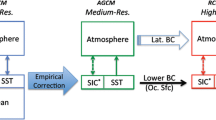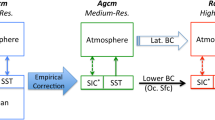Abstract
We use a quantile-based bias correction technique and a multi-member ensemble of the atmospheric component of NCAR CCSM3 (CAM3) simulations to investigate the influence of sea surface temperature (SST) biases on future climate change projections. The simulations, which cover 1977–1999 in the historical period and 2077–2099 in the future (A1B) period, use the CCSM3-generated SSTs as prescribed boundary conditions. Bias correction is applied to the monthly time-series of SSTs so that the simulated changes in SST mean and variability are preserved. Our comparison of CAM3 simulations with and without SST correction shows that the SST biases affect the precipitation distribution in CAM3 over many regions by introducing errors in atmospheric moisture content and upper-level (lower-level) divergence (convergence). Also, bias correction leads to significantly different precipitation and surface temperature changes over many oceanic and terrestrial regions (predominantly in the tropics) in response to the future anthropogenic increases in greenhouse forcing. The differences in the precipitation response from SST bias correction occur both in the mean and the percent change, and are independent of the ocean–atmosphere coupling. Many of these differences are comparable to or larger than the spread of future precipitation changes across the CMIP3 ensemble. Such biases can affect the simulated terrestrial feedbacks and thermohaline circulations in coupled climate model integrations through changes in the hydrological cycle and ocean salinity. Moreover, biases in CCSM3-generated SSTs are generally similar to the biases in CMIP3 ensemble mean SSTs, suggesting that other GCMs may display a similar sensitivity of projected climate change to SST errors. These results help to quantify the influence of climate model biases on the simulated climate change, and therefore should inform the effort to further develop approaches for reliable climate change projection.













Similar content being viewed by others
References
Allan RP, Soden BJ (2008) Atmospheric warming and the amplification of precipitation extremes. Science 321(5895):1481–1484
Ashfaq M et al (2010) Influence of climate model biases and daily-scale temperature and precipitation events on hydrological impacts assessment––a case study of the United States. J Geophys Res. doi:10.1029/2009JD012965
Bjerknes J (1969) Atmospheric teleconnections from Equatorial Pacific. Mon Weather Rev 97(3):163–172
Bony S et al (1997) Sea surface temperature and large-scale circulation influences on tropical greenhouse effect and cloud radiative forcing. J Clim 10(8):2055–2077
Cazenave A et al (2003) Present-day sea level change: observations and causes. Space Sci Rev 108(1–2):131–144
Chang P et al (2000) The effect of local sea surface temperatures on atmospheric circulation over the tropical Atlantic sector. J Clim 13(13):2195–2216
Chang CY et al (2007) Seasonal climate of the tropical Atlantic sector in the NCAR community climate system model 3: error structure and probable causes of errors. J Clim 20(6):1053–1070
Collins WD et al (2006) The community climate system model version 3 (CCSM3). J Clim 19(11):2122–2143
Easterling DR et al (2000) Climate extremes: observations, modeling, and impacts. Science 289(5487):2068–2074
Folland CK et al (1986) Sahel rainfall and worldwide sea temperatures, 1901–1985. Nature 320(6063):602–607
Gillett NP et al (2008) Attribution of cyclogenesis region sea surface temperature change to anthropogenic influence. Geophys Res Lett 35(9):L09707
Good P et al (2009) Understanding uncertainty in future projections for the tropical Atlantic: relationships with the unforced climate. Clim Dyn 32(2–3):205–218
Graham NE et al (1994) On the roles of tropical and midlatitude SSTs in forcing interannual to interdecadal variability in the winter Northern Hemisphere circulation. J Clim 7(9):1416–1441
Hack JJ et al (2006) Simulation of the global hydrological cycle in the CCSM community atmosphere model version 3 (CAM3): mean features. J Clim 19(11):2199–2221
Hastenrath S (1978) Modes of tropical circulation and climate anomalies. J Atmos Sci 35(12):2222–2231
Hoerling M et al (2008) What is causing the variability in global mean land temperature? Geophys Res Lett 35(23):L23712
Hurrell JW et al (2006) The dynamical simulation of the community atmosphere model version 3 (CAM3). J Clim 19(11):2162–2183
IPCC (2007) Climate Change 2007: the physical science basis. In: Solomon S et al (eds) Contribution of Working Group I to the Fourth Assessment Report of the Intergovernmental Panel on Climate Change. Cambridge, UK
Large WG, Danabasoglu G (2006) Attribution and Impacts of Upper-Ocean Biases in CCSM3. J Clim 19(11):2325–2346
Lin J-L (2007) The double-ITCZ problem in IPCC AR4 coupled GCMs: ocean–atmosphere feedback analysis. J Clim 20(18):4497–4525
McPhaden MJ, Zhang DX (2002) Slowdown of the meridional overturning circulation in the upper Pacific Ocean. Nature 415(6872):603–608
Meehl GA et al (2005) How much more global warming and sea level rise? Science 307(5716):1769–1772
Meehl GA et al (2006a) Monsoon regimes in the CCSM3. J Clim 19(11):2482–2495
Meehl GA et al (2006b) Climate change projections for the twenty-first century and climate change commitment in the CCSM3. J Clim 19(11):2597–2616
Rayner NA et al (2003) Global analyses of sea surface temperature, sea ice, and night marine air temperature since the late nineteenth century. J Geophys Res Atmos 108(D14):4407
Reynolds RW et al (2002) An improved in situ and satellite SST analysis for climate. J Clim 15(13):1609–1625
Richter I, Xie SP (2008) On the origin of equatorial Atlantic biases in coupled general circulation models. Clim Dyn 31(5):587–598
Rodwell MJ et al (1999) Oceanic forcing of the wintertime North Atlantic Oscillation and European climate. Nature 398(6725):320–323
Santer BD et al (2006) Forced and unforced ocean temperature changes in Atlantic and Pacific tropical cyclogenesis regions. Proc Natl Acad Sci USA 103(38):13905–13910
Schneider EK et al (2009) A statistical–dynamical estimate of winter ENSO teleconnections in a future climate. J Clim 22(24):6624–6638
Song X, Zhang GJ (2009) Convection parameterization, tropical Pacific double ITCZ, and Upper-Ocean Biases in the NCAR CCSM3, part I: climatology and atmospheric feedback. J Clim 22(16):4299–4315
Stroeve J, Serreze M, Drobot S, Gearheard S, Holland M, Maslanik J, Meier W, Scambos T (2008) Arctic Sea Ice Extent Plummets in 2007. EOS Trans AGU 89(2). doi:10.1029/2008EO020001
Thompson L, Cheng W (2008) Water masses in the Pacific in CCSM3. J Clim 21(17):4514–4528
Trenberth KE et al (2000) The global monsoon as seen through the divergent atmospheric circulation. J Clim 13(22):3969–3993
Vecchi GA et al (2006) Weakening of tropical Pacific atmospheric circulation due to anthropogenic forcing. Nature 441(7089):73–76
Wang HJ (2001) The weakening of the Asian monsoon circulation after the end of 1970’s. Adv Atmos Sci 18(3):376–386
Wang CZ (2004) ENSO, Atlantic climate variability, and the Walker and Hadley circulations. In: Diaz HF, Bradley RS (eds) Hadley circulation: present, past and future, vol 21. Kluwer, The Netherlands, pp 173–202 (see also p 511)
Wang B et al (2004) Ensemble simulations of Asian–Australian monsoon variability by 11 AGCMs. J Clim 17(4):803–818
Yin JH (2005) A consistent poleward shift of the storm tracks in simulations of 21st century climate. Geophys Res Lett 32:L18701. doi:10.1029/2005GL023684
Zhang GJ, Wang H (2006) Toward mitigating the double ITCZ problem in NCAR CCSM3. Geophys Res Lett 33:L06709. doi:10.1029/2005GL025229
Acknowledgments
We thank two anonymous reviewers for their constructive and insightful comments. This work was supported in part by NSF award 0450221, DOE awards DE-FG02-08ER64649 and DE-SC0001483, and by the World Bank’s Trust Fund for Environmentally and Socially Sustainable Development. The CAM3 simulations and analyses were enabled by computational resources provided by Information Technology at Purdue (the Rosen Center for Advanced Computing, West Lafayette, Indiana). We thank the CCSM Climate Change Working group at NCAR for access to the CCSM3 simulations. NCEP Reanalysis data were provided by the NOAA/OAR/ESRL PSD, Boulder, Colorado, USA, from their Web site at http://www.cdc.noaa.gov/. This is PCCRC paper number 0922.
Author information
Authors and Affiliations
Corresponding author
Rights and permissions
About this article
Cite this article
Ashfaq, M., Skinner, C.B. & Diffenbaugh, N.S. Influence of SST biases on future climate change projections. Clim Dyn 36, 1303–1319 (2011). https://doi.org/10.1007/s00382-010-0875-2
Received:
Accepted:
Published:
Issue Date:
DOI: https://doi.org/10.1007/s00382-010-0875-2




